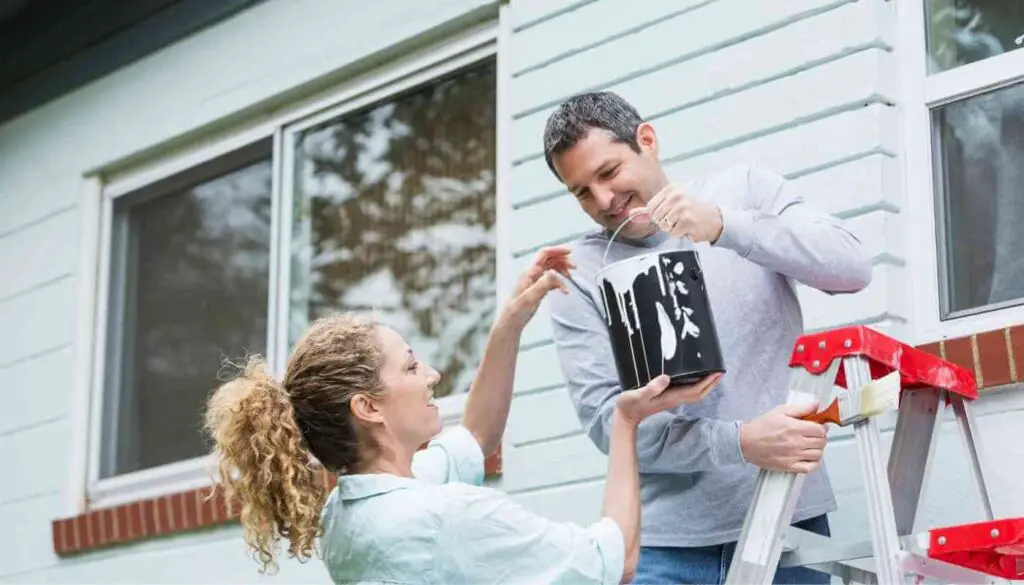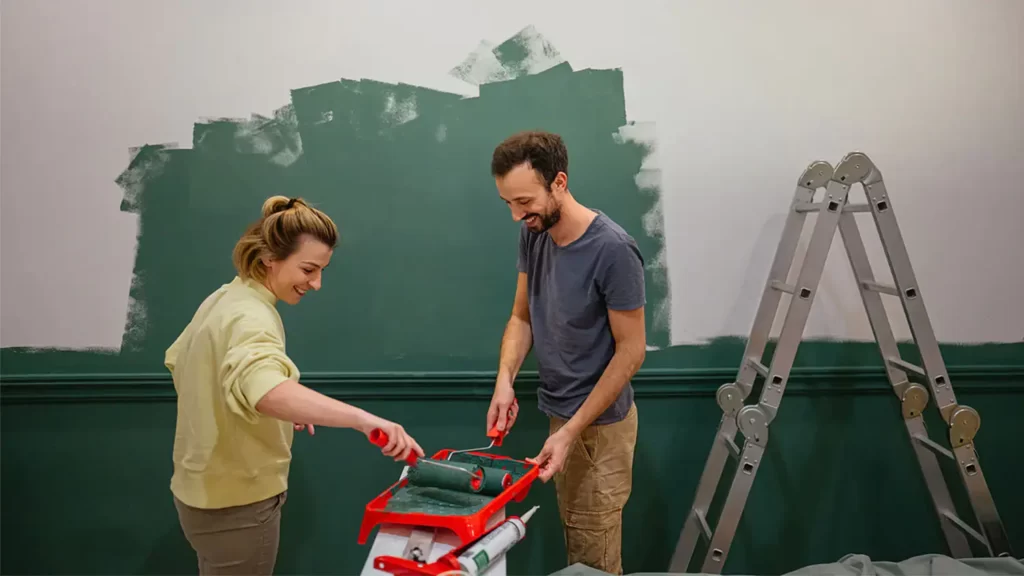Last Updated on August 2, 2023 By Emma W. Thomas
If you accidentally paint interior paint outside, quickly clean up the spill or splatter with a damp cloth or sponge before it dries. If the paint dries, use a scraper to gently remove it. If needed, repaint the affected area to match the original color.
What To Do If One Accidentally Paints Interior Paint Outside
Painting your home isn’t just a matter of color selection, but also about choosing the right type of paint. Interior and exterior paints are formulated differently, each designed specifically for use either indoors or outdoors. But mistakes happen, and one may end up inadvertently using interior paint outside. If such blunders occur, here are steps to fix the situation.
Step One: Assess the Situation
The first step is always to examine the extent of the issue. Determine how much of the exterior has been painted with the interior paint. The magnitude of the problem will guide the course of action to take.
Step Two: Purchase Suitable Exterior Paint
Next, it’s crucial to select paint that is designed specifically for exterior use. Exterior paints are made to withstand harsh weather conditions like rain, sun, wind, and dust, which interior paints are not formulated to handle.
Step Three: Gather the Necessary Materials
Once the paint is settled, gather other essential materials. This may include a power washer, scrub brushes, paint remover, primer, and other painting supplies like rollers or brushes.
Step Four: Remove the Interior Paint
Interior paint needs to be removed before applying exterior paint. Power washing is generally effective for this task, but some stubborn areas may require hand scrubbing with a brush.
Step Five: Apply Primer
After cleaning and drying the affected area, apply a layer of primer. This prepares the surface, ensuring the exterior paint adheres properly and lasts longer.
Step Six: Apply Exterior Paint
Finally, apply the exterior paint as per the manufacturer’s instructions. Apply multiple thin layers rather than one thick layer, allowing sufficient drying time between each, for a smoother, more durable finish.
| Step | Action |
|---|---|
| 1 | Assess the situation |
| 2 | Purchase suitable exterior paint |
| 3 | Gather necessary materials |
| 4 | Remove the interior paint |
| 5 | Apply primer |
| 6 | Apply exterior paint |
What Happens When One Uses Interior Paint Externally?

Using interior paint on external surfaces will lead to problems since the paint was purposely manufactured for internal surfaces. For instance, one may notice that the paint does not adhere to the external surface since internal paints are thin. A lot of paint will be required for an internal painting to adhere to an external surface by applying several layers. Additionally, when used internally, internal paint appears to have patches and lumps, creating that unprofessional look. In most cases, it results from the many layers of paint, making it difficult to come up with an even coat.
Internal paint also takes longer to dry, especially when used on external surfaces due to changes in its normal environment. Sometimes it even fails to dry when the location experiences overly dump and cold conditions. It also fails to have additives similar to those of external paint, such as withstand some weather conditions like rain and frost, which cause the internal paint to peel off and fall out of the painted surface. Other conditions such as too much sunlight on an external surface painted with internal paint can lead to a wide range of serious problems. Too much sunlight on internal paint results in fading, creating an undesired outcome.
What Is The Difference Between Interior Paint And Exterior Paint?
There are many differences between these two paints. However, the primary difference between them is the resin. Resin is an ingredient used in paints whose main purpose is to bind paints’ pigment to the surface. Exterior paints have soft resin to survive harsh weather conditions such as high temperatures and moisture in the environment. The soft resin helps the exterior paint by making it tougher, resisting chipping, fading, or peeling from too much sunlight.
On the other hand, interior paint has its resin rigid and less soft. There are no temperature problems involved inside a room, and it is not as exposed to harsh environmental factors as external paint. The rigidity of internal paint also helps in easing the painting process as it reduces the scuffing and smearing efforts.
Another difference between the two paints is that exterior paints outgas more than interior paint. Exterior paint usually outgasses for about 48 hours after painting but continues, though in small amounts for years. For this reason, one should as much as possible avoid using external paints internally as these gases are health hazards. Internal paint is delicate and does not outgas the same way as exterior paint; hence safe to use indoors. When applying interior paint, one must clean and scrub the surfaces since it resists scrubbed surfaces better to provide a smooth smear creating an appealing aesthetic look.
Exterior paints are better outside since they provide a better cover from their strong sticking ability and durability. However, they are not suitable for interior use as they have chemicals that may be hazardous when internally used. The chemical component of exterior paints makes them release gasses that can be harmful when inhaled for a long time. It is only safe when externally used as it does not affect the external environment. On the other hand, internal paints may be less durable but safe for internal use. Chemicals used in internal paints have less or no gas out and do not pose any health threat when used on interior walls.
Can One Use Interior Paint On The Outside?
Interior paint has unique features that make it preferable for use indoors with the interior environment. One unique feature is that interior paint has a low odor compared to other paints. It also has a spatter resistance which makes it easy to smear. Being classified as interior paint means it is strictly for interior use only. Interior paint lacks heavy-duty chemicals and additives to withstand harsh weather conditions. It is likely to easily break down when externally exposed as it will chalk and fade out. It also lacks the adhesion properties contained in the external paints, and using it externally becomes void.
However, other paints are referred to as hybrid interior/exterior paints, which serve as multipurpose paints. They can be used internally and externally even though they lack some heavy-duty resistance and toughness of normal exterior paint. For this reason, they are only used externally for convenience as they only serve for a short time under specific weather conditions. Such paints are mostly used in garage areas and as coatings for small jobs like doors and door frames and other surfaces that are less exposed to harsh conditions.
Can One Paint Interior Paint Over Exterior Paint?
The answer to this question is yes. One can apply interior paint over exterior paint, but the process does not make much sense. The reason is that the interior paint’s absorption capability will be weak since it is specifically classified for internal use. It will fail to provide the necessary grip on the surface. After a few months, the result of the external surface will have a flaky appearance with paint peeling off. Such surfaces require a lot of effort and cleaning up in case one will need to repaint them. When used on an inside wall, the appearance would look great even though a primer paint layer would need to be applied first. Applying interior paint over e is a waste of both paints, especially when used on an exterior surface.
What Are The Common Unique Features Of Interior Paint?

All paints are made from four basic ingredients, which are solvents, resin pigments, and additives. However, manufacturing the nature of ingredients used differs in different paints depending on the environments and surfaces they will be subjected to. Interior paints share common pigments with exterior paints, but it is usually higher in exterior paints. The following are some unique characteristics of interior paints that make them different from other paints;
- Interior paints have additives that make their maintenance, washability, and dampness prevention easy. They have to maintain their main purpose: decorate and create an aesthetic look in a room.
- Interior paints are also designed to withstand abrasion and are very delicate. They are manufactured to be delicate as they occupy the same space as the people living in the painted house. They should co-exist without interfering with the people’s normal way of life, such as outgassing, which may be very uncomfortable.
- It is formulated to be resistant to physical damage, such as the ability to resist straining. It is also easy to scrub and clean, making it easy to prepare to paint an overcoat.
- The resin used in interior paint is firmer than other paints since it is not formulated to withstand exterior weather conditions. This property of interior paint prevents it from fading away quickly, provided it is not subjected to exterior temperature changes and humidity.
- Interior paint is made to be stain-resistant, especially for roller marks and hiding brushes since it is interiorly used. It, therefore, can maintain its neatness by resisting stains.
- Interior paints get cured or dry without exposing them to any form of high temperature or sunlight. The reason is that interior paint is classified for interior use, and its functionality goes in line with interior conditions. Exposing it to a higher temperature than room temperature will provide different results such as unevenness or layering of dry paint.
- It lacks some additives such as pesticides and fungicides used in other paints to keep away pests.
- Most interior paints are easily washable to clean and get rid of minor spots and marks that kids may accidentally get to the wall. They achieve this without losing their look and feel and peeling off. They can be cleaned and still maintain their aesthetic quality.
- Interior paints are made with low or zero VOC (Volatile Organic Compounds). Low VOC helps maintain the air quality in one’s home since there is no outgassing from the paint. It also reduces associated health risks from outgassing which could be fatal if experienced for a long time.
Conclusion
Using interior paint outside can be easily rectified with a few options, such as leaving the paint as is. The other option could be painting an exterior paint over it, which would not provide a professional look. The best option would be to clean out the paint and use exterior paint. It is easy since less preparation will be required, which involves a little rubbing of the interior paint. Leaving it to be will not create a good look since interior paint easily fades and washes off when exposed to external weather conditions such as sunlight and rain.
References:
https://www.homesandgardens.com/interior-design/paint/can-you-use-interior-paint-outside
https://www.homemindset.com/accidentally-used-interior-paint-outside/
Emma is a graduate of Domestic Science or Family and Consumer Sciences (Home Economics) from the University of Wisconsin. She has 7 years of experience Working with the strategic section of BestBuy and now writing full-time for Homeeon.
From Managing the Home, Interiors, Cleaning, and Exteriors to Gardening and everything about Making A Home Liveable – is her passion and this Homeeon is the result of this.
Emma loves decorating her home with the best stuff found online. She cares about quality over anything and writes reviews about them here in Homeeon. Get in touch with her over Pinterest.
Keep reading her blogs.

